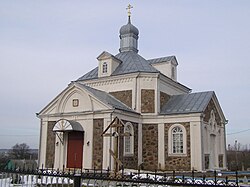Kapyl (Belarusian: Капыль, romanized: Kapyĺ; Russian: Копыль, romanized: Kopyl; Polish: Kopyl; Lithuanian: Kapylius; Yiddish: קאפּוליע) is a town in Minsk Region, Belarus. It serves as the administrative center of Kapyl District.[1] It is located 34 kilometers (21 mi) west-northwest of Slutsk and 90 kilometers (56 mi) south-southwest of the capital Minsk.[3] In 2009, its estimated population was 9,900 based on the provisional figures from the 2009 census.[4] As of 2024, it has a population of 9,985.[1]
Kapyl
Kopyl | |
|---|---|
 | |
| Coordinates: 53°09′0″N 27°05′30″E / 53.15000°N 27.09167°E | |
| Country | Belarus |
| Region | Minsk Region |
| District | Kapyl District |
| First mentioned | 1274 |
| Population (2024)[1] | |
• Total | 9,985 |
| Time zone | UTC+3 (MSK) |
| Postal code | 223 910, 223 927[2] |
| Area code | +375 1719 |
| License plate | 5 |
History
editKapyl, first mentioned in 1274,[5] was a walled town that was noteworthy by the 14th century, and is listed in the atlas of Ortelius of 1574.[6] During the 14th century the town was part of the Grand Duchy of Lithuania. In 1395 it came into the possession of Prince Vladimir Olgerdovich and his heirs, the Olelkovich family, where it remained until 1612. Kapyl was part of the dowry of Zofia Olelkowicz Słucka and was one of the seven fortified towns left to her husband Janusz Radziwill upon her death in 1612.[6] Kapyl was attacked by the Tatars numerous times and was sacked on at least one occasion during the 16th century.[6]
On August 27, 1652, Kapyl received the Magdeburg Law and gained its own seal, a coat of arms depicting a hunting horn on a gold field. With this privilege came the right to hold fairs and weekly auctions. During the 16th century weaving became established in the town, including the production of velvet. Six guilds came into existence as a result of the growth of the weaving industry.
After the Second Partition of Poland in 1793 Kapyl became part of the Russian Empire. From 1832 it became a personal holding of Prince Wittgenstein. During the 19th century local businesses included a brewery, 2 water mills, and 6 shops. Other local institutions included 3 schools, churches (including a Calvinist church), and 2 Jewish synagogues.
Towards the end of the 19th century Kapyl had over 350 houses and over 2000 inhabitants. At that time a majority of the town's population was Jewish.[6] By 1900 the Jewish population was 2,671.[3]
In 1924, Kapyl became the capital city of the Kapyl District.
During World War II the Slutsk-Kapyl area was the subject of a German military operation code-named Erntefest II (Harvest Festival) which ended in February 1943. Although ostensibly aimed at suppressing the activities of Soviet partisans in the area the operation resulted in the deaths of 2,325 of the local inhabitants (against the loss of six German soldiers), which can only be characterized as a campaign of genocide and terror.[7]
One of Kapyl district's major architectural monuments is a 19th-century church in the town itself.[8]
Notable people
edit- Abraham Jacob Paperna, educator and author
- Mendele Mocher Sforim, author
- Renald Knysh, gymnastics coach
- Zmicier Zhylunovich, writer and political leader
Sister cities
editSee also
editReferences
edit- ^ a b c "Численность населения на 1 января 2024 г. и среднегодовая численность населения за 2023 год по Республике Беларусь в разрезе областей, районов, городов, поселков городского типа". belsat.gov.by. Archived from the original on 2 April 2024. Retrieved 9 April 2024.
- ^ [1] Archived 2012-02-27 at the Wayback Machine Kopyl raion page at Minsk Oblispolkom website accessed 13 July 2010
- ^ a b "Technical Problem Form". www.jewishgen.org.
- ^ "Belarus City Population accessed 13 July 2010".
- ^ Kopyl Region Executive Committee website retrieved 20 July 2010
- ^ a b c d "Słownik geograficzny Królestwa Polskiego i innych krajów słowiańskich, Tom IV - wynik wyszukiwania - DIR". dir.icm.edu.pl.
- ^ "Major Antipartisan Operations in Belorussia - Reference & Links - Forschungsamt - RODOH Forum - Message Board". October 25, 2010. Archived from the original on 2010-10-25.
- ^ "TrekLens | Learning about photography through our world". www.treklens.com.
- ^ "International Relations". joniskis.lt. Retrieved 29 April 2014.
Further reading
editExternal links
edit- Media related to Kapyl at Wikimedia Commons
- Kapyl, Belarus at JewishGen
- Kapyl District at Treklens
- Kopyl raion page at Minsk Oblispolkom website
- Rodoh Forum: Major Antipartisan Operations in Belorussia
- Kopyl Region Executive Committee
- Belarus City Population


